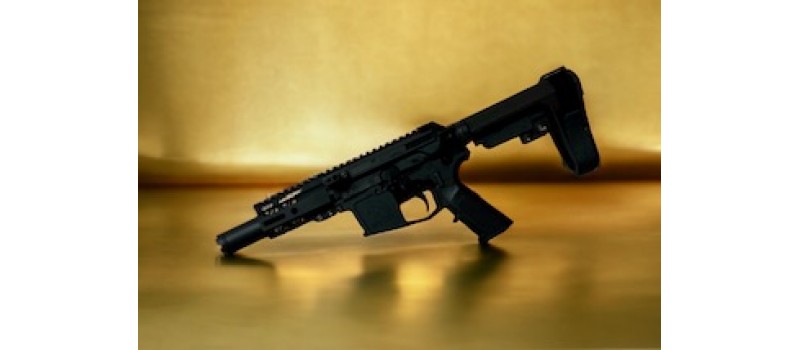If you're a gun enthusiast, you've likely encountered the terms AR pistol and SBR (Short-Barreled Rifle) thrown around in discussions, reviews, and forums. Both terms are commonly associated with AR-15 style firearms, but they’re not interchangeable. Whether you're contemplating building your next gun or just curious about these two classifications, understanding the difference between an AR pistol and an SBR is crucial, especially when it comes to legal compliance, performance, and functionality.
The Basics: What Defines an AR Pistol?
At first glance, the AR pistol might look similar to its rifle counterpart, but there's one key defining feature: the barrel length. An AR pistol is typically defined by having a barrel length of less than 16 inches, with the most common being around 10.5 to 11.5 inches. But the defining characteristic isn’t just the barrel; it’s also the lack of a stock.
Key Features of an AR Pistol:
- Barrel Length: Less than 16 inches (usually around 10.5” to 11.5”).
- No Stock: AR pistols cannot have a stock, which is what distinguishes them from rifles. Instead, AR pistols have a brace, which is designed to be fired with one hand.
- Legal Classification: AR pistols are classified as pistols, not rifles, according to the ATF, as long as they meet the criteria above.
- Brace vs. Stock: A brace allows you to stabilize the firearm, but it's not designed for your shoulder (although some people have used braces in this way, which has led to legal gray areas).
Why do some people love AR pistols? They offer a lot of firepower and maneuverability in a compact package. The shorter barrel size means it’s easier to carry in tight spaces (think vehicle carry, home defense, or even backpack carry). Plus, there's no need for a tax stamp to own an AR pistol, making it a more accessible option for enthusiasts who want to avoid the extra paperwork and wait time required for an SBR.
What’s an SBR? Short-Barreled Rifle Explained
An SBR, or Short-Barreled Rifle, shares many similarities with an AR-15 rifle, but the most important difference is the barrel length—it’s shorter than 16 inches. This modification makes it easier to handle and maneuver, but unlike an AR pistol, an SBR requires a tax stamp from the ATF and must comply with NFA (National Firearms Act) regulations.
Key Features of an SBR:
- Barrel Length: Less than 16 inches.
- Stock: SBRs are designed to have a stock (like a traditional rifle), allowing you to stabilize the firearm against your shoulder for more accurate shooting.
- NFA Compliance: Because an SBR is classified as a rifle by the ATF, it’s subject to NFA rules. This means you need to fill out an ATF Form 1 or Form 4, pay a $200 tax stamp, and wait for approval (usually 6 months to a year) before you can legally own it.
- Overall Length: An SBR must also meet the legal overall length requirement of 26 inches, which prevents it from being classified as a "firearm" (a firearm is defined differently in the ATF's eyes and comes with its own restrictions).
What makes an SBR popular among gun enthusiasts? The accuracy and ergonomics that come with a stock, combined with the versatility of a shorter barrel, make it an ideal choice for tactical shooters, home defense, or close-quarters combat situations. The addition of a stock makes it easier to shoot accurately and comfortably compared to an AR pistol, especially during prolonged use.
Key Differences Between an AR Pistol and SBR
Now that we’ve covered the basics, let’s break it down:
| Feature | AR Pistol | SBR (Short-Barreled Rifle) |
|---|---|---|
| Barrel Length | Less than 16 inches (typically 10.5”-11.5”) | Less than 16 inches |
| Stock | No stock (must have a brace) | Has a stock for shoulder support |
| Legal Requirements | No NFA registration or tax stamp required | NFA registered, requires a $200 tax stamp and ATF approval |
| Overall Length | No requirement for total length | Must be at least 26 inches overall length |
| Primary Use | Compact, lightweight, easy to carry | More ergonomic for precision and stability |
| Approval Process | None required | Must file with ATF, pay tax, wait for approval |
So, Which One Should You Choose?
It all depends on your needs, preferences, and legal considerations. Here’s a quick breakdown:
Choose an AR Pistol If:
- You want a compact, maneuverable firearm that’s easy to carry or store.
- You don’t want to deal with NFA paperwork or waiting for approval.
- You prefer the flexibility of a brace instead of a stock.
- You’re looking for something ideal for home defense, vehicle carry, or close-range use.
Choose an SBR If:
- You prefer the ergonomics of a stock and the ability to shoot with more precision and stability.
- You’re willing to go through the NFA process and pay the $200 tax stamp.
- You need a tactical rifle with shorter length but the ability to shoulder the stock for better control, especially in a combat or defensive situation.
- You enjoy the idea of having a rifle-class firearm that is still more maneuverable and easy to handle in confined spaces.
Final Thoughts
Both the AR pistol and SBR offer unique advantages, depending on your intended use. The AR pistol is a more accessible option that provides a compact firearm with fewer legal hurdles. Meanwhile, the SBR offers a bit more accuracy and stability, thanks to the stock, but comes with the responsibility of dealing with the NFA regulations.
At the end of the day, the right choice boils down to your specific needs, what you value in a firearm, and how much time you’re willing to spend on the legal process. Whether you’re building a home defense weapon or just want to add something unique to your collection, both options have their place in the world of tactical firearms.
What’s your preference? AR pistol or SBR? Let us know in the comments below!
Stay safe, stay legal, and happy shooting!




